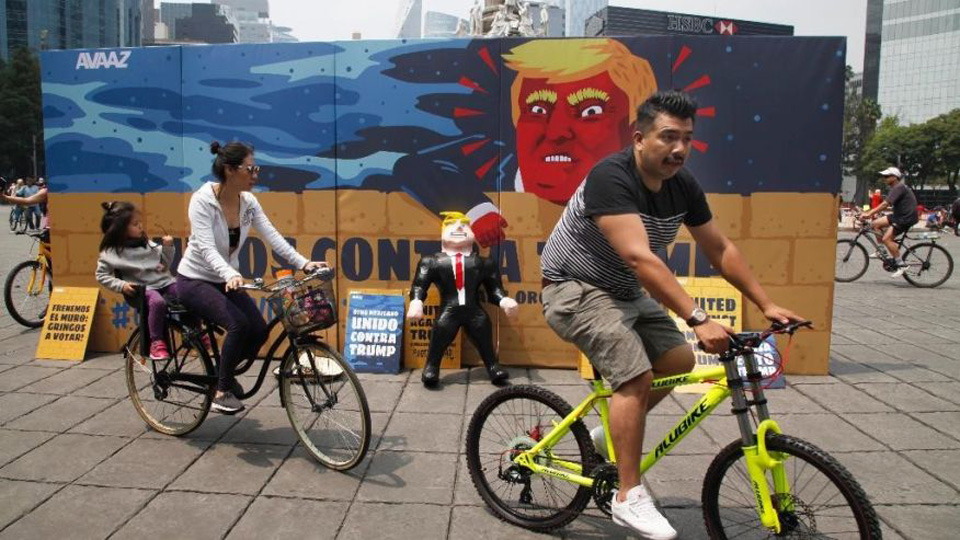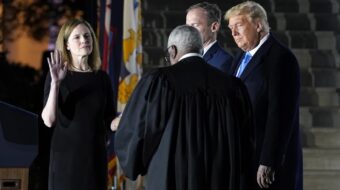
The new Donald Trump administration’s foreign policy direction is not the easiest thing to follow. But a fascination with Mexico, so evident during the presidential campaign, continues to be a central thread. This is not good for working people either in Mexico or in the United States.
The latest flap comes from a telephone conversation that took place on Friday, January 27, between Trump and Mexican President Enrique Peña Nieto. Supposedly, Trump accused the Mexican army of cowardice in fighting against the “bad hombres” in the drug cartels down there, and threatened to send in U.S. troops to do the job for them if the Mexican troops are not up to the job.
This conversation appears to have been leaked to the press, including AP. It was publicized in various U.S. and Mexican media and by Carmen Arestegui, a left-leaning independent journalist. Both the U.S. and Mexican governments, the latter via Foreign Minister Luis Videgaray, deny the veracity of the story. Trump says he was just joshing. We shall see. At any rate, the story got a pretty negative reaction in Mexico. Two senators belonging to the left wing Morena political party, Layda Sansores San Román and Manuel Bartlett, demanded that the Mexican government reveal the real content of the phone call and, if Trump had really threatened to send troops to Mexico, whether as a joke or not, demand an apology from the United States.
The idea of U.S. troops entering Mexico is wildly unpopular. The Mexican people remember, while many people in the United States have forgotten or never even learned in school or from our media, about the precedents for such interventions. Between 1846 and 1848, the United States invaded Mexico and did not pull the troops out until Mexico agreed to cede a huge swath of territory, including all of California, Arizona, Utah, New Mexico and parts of several other states. That territory, plus most of Texas which the United States had got its hands on earlier, amounted to more than half of Mexico’s pre-war land.
In 1913, the U.S. ambassador in Mexico City, Henry Lane Wilson, connived in a successful plot by Mexican military officers to overthrow and murder President Francisco Ignacio Madero and replace him with a dictator, Victoriano Huerta. In April 1914, U.S. President Woodrow Wilson sent troops to occupy the Mexican Caribbean port of Veracruz. The original reason given was that Mexico had refused to fire a salute by way of apology for the brief detention of some U.S. Navy sailors, though it was also claimed that Germany was planning to send a shipment of arms to Mexico. In 1916-1917, the United States sent troops under General John Pershing, the future U.S. commander in the First World War, to invade northern Mexico in pursuit of the revolutionary fighter Francisco “Pancho” Villa whose fighters had crossed the border and raided the town of Columbus, New Mexico.
In 1846-1848, 1914 and 1916-1917, the Mexican civilian population fought back fiercely against the invaders from the north, even though during each of those incidents, the government in Mexico City was not very popular or effective.
An article by Jorge Carrasco Araizaga, writing in the Mexican news magazine Proceso, has provided more information on what might be afoot in terms of the U.S. government and military’s focus Mexico.
According to this, there has been an increased level of interest on the part of the U.S. military in matters regarding not only the U.S.-Mexico border but the border between Mexico and its Southern neighbor, Guatemala. According to Carrasco, the leadership of the U.S. armed forces is taking a close look not only at the U.S. – Mexico border, but also at Mexico’s southern border with Guatemala.
Trump’s nominee for Secretary of Homeland Security, General John Kelly, has been personally involved in aerial surveillance of the Texas-Mexico border, according to Carrasco’s article. Meanwhile, high level U.S. military officers have been inspecting the border between Guatemala and the Mexican state of Chiapas, with a view to assessing Mexico’s efforts to keep unauthorized migrants crossing from Central America into Mexico on their way to the United States.
This interest is not new. The so called “Merida Initiative”, negotiated between U.S. President George W. Bush and then-Mexican President Felipe Calderon in 2006, has channeled nearly $2 billion in U.S. government funds into crime prevention and control efforts, concentrated on the drug trade, in Mexico and Central America, and counting. There is little positive to show for it as violent crime rates have continued to climb, with at least 80,000 deaths since the Merida Initiative began. The bonanza of U.S. money is seen by many as having had a corrupting influence on police and officials in Mexico and Central America. And one can only speculate as to what might have been accomplished if those funds had been invested in health care, education and jobs rather than in the military. Or if instead of throwing money into poorly thought out military solutions, the United States would have invested it in fighting drug addiction and abuse here at home, for without the huge market for drugs right here in the United States, there would be no drug smuggling problem worth speaking of.
The Obama administration had enlisted Mexico in efforts to block refugees and migrants from travelling across Mexico south to north in their efforts to get to U.S. territory. This had the result that migrants were forced to take even more dangerous routes to evade Mexican patrols, and there are many reports of abuse of migrants by Mexican security personnel. An April 2015 report by the Georgetown Law Human Rights Institute shows that shifting U.S. immigration enforcement functions onto Mexican security personnel on the Mexico-Guatemala border has had a particularly dire impact on the situation of Central American child migrants.
What the Mexican government is now going to do with regard to Trump’s wall remains to be seen. But it seems very likely that Peña Nieto will find some way to work with the Trump administration that keeps the money flowing. Trump’s vulgar insults hurled against the Mexican people will not impede that.












Comments